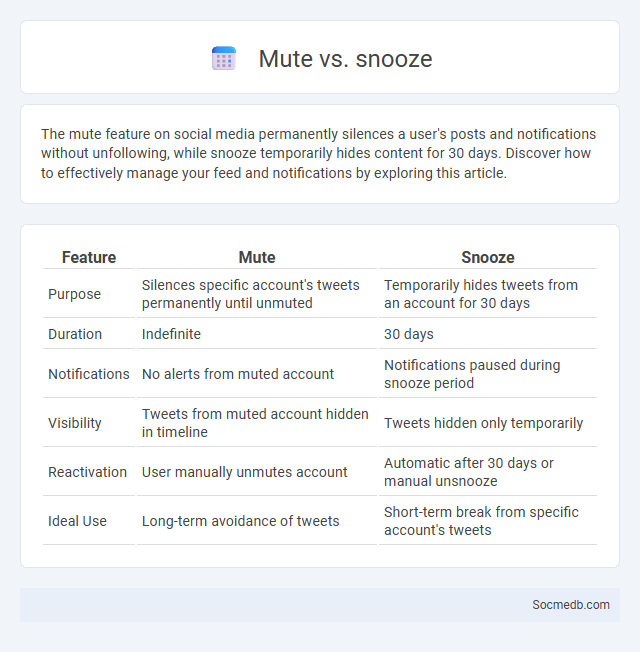
Photo illustration: mute vs snooze
The mute feature on social media permanently silences a user's posts and notifications without unfollowing, while snooze temporarily hides content for 30 days. Discover how to effectively manage your feed and notifications by exploring this article.
Table of Comparison
| Feature | Mute | Snooze |
|---|---|---|
| Purpose | Silences specific account's tweets permanently until unmuted | Temporarily hides tweets from an account for 30 days |
| Duration | Indefinite | 30 days |
| Notifications | No alerts from muted account | Notifications paused during snooze period |
| Visibility | Tweets from muted account hidden in timeline | Tweets hidden only temporarily |
| Reactivation | User manually unmutes account | Automatic after 30 days or manual unsnooze |
| Ideal Use | Long-term avoidance of tweets | Short-term break from specific account's tweets |
Understanding Notification Controls: Mute vs Snooze
Users leverage notification controls to tailor their social media experience by managing interruptions effectively. Muting a conversation or account disables all alerts permanently until manually unmuted, allowing complete silence without losing content updates. Snoozing pauses notifications temporarily for a set period, providing a hassle-free break while keeping users connected and informed once the snooze expires.
What Does “Mute” Mean in Digital Platforms?
On digital platforms, "mute" refers to the function that allows users to silence notifications or hide content from specific accounts without unfollowing or blocking them, enabling a more controlled and personalized social media experience. This feature is crucial for managing the flow of information and maintaining digital well-being by reducing exposure to unwanted posts or interactions. Platforms like Twitter, Instagram, and Facebook incorporate mute options to help users tailor their social feeds while preserving social connections.
The Functionality of “Snooze” and How It Works
The functionality of the "Snooze" feature on social media allows you to temporarily hide posts from specific accounts without unfollowing or blocking them. It works by muting content from selected users, pages, or groups for 30 days, reducing clutter and improving your feed relevance. This feature helps Your social media experience stay personalized while avoiding potentially unwanted or overwhelming posts.
Key Differences Between Mute and Snooze Features
The mute feature on social media allows users to completely silence notifications from a person or group without unfollowing or blocking, maintaining the connection invisibly. The snooze feature temporarily hides posts from a specific account or group for a set period, typically 30 days, after which posts reappear in the feed automatically. Mute provides an indefinite, passive notification block, while snooze offers a temporary, active break from visible content.
When to Use Mute: Ideal Scenarios
Use mute on social media when encountering repetitive notifications from group chats or promotional content that clutters your feed. Muting is effective during live events or breaking news where volume spikes but individual alerts are unnecessary. It helps maintain focus by silencing distracting accounts without unfollowing or blocking, preserving connections while reducing noise.
When Snooze is the Better Option
When managing your social media presence, choosing to snooze notifications or content can significantly enhance your mental well-being by preventing information overload and reducing stress. Tailoring your feed by temporarily muting distracting accounts allows you to maintain focus on meaningful interactions without permanently unfollowing valuable connections. Consider snoozing during high-pressure periods to create a healthier digital environment that supports your productivity and emotional balance.
Comparing User Experience: Mute vs Snooze
Mute functions by immediately silencing notifications from a specific user or group, enhancing user control over distraction without permanently severing connections. Snooze temporarily pauses notifications and updates for a selected period, offering a flexible break while preserving ongoing engagement. Both features improve user experience by tailoring interaction intensity, but Mute suits users seeking long-term quietness, whereas Snooze benefits those needing short-term relief.
Potential Drawbacks of Muting and Snoozing Notifications
Muting and snoozing notifications on social media can lead to missed important updates or urgent messages, potentially affecting your timely responses. These features may also cause a buildup of unseen content, increasing the chances of information overload once notifications are revisited. Managing your notification preferences wisely is crucial to maintaining balanced digital engagement without sacrificing essential communication.
How to Customize Notifications for Optimal Focus
Customize notifications by selecting only crucial alerts from specific social media platforms to minimize distractions. Use settings like Do Not Disturb or focus modes on your device to silence non-essential updates during peak productivity hours. Tailoring these preferences ensures your notifications support your goals without overwhelming your attention.
Best Practices for Managing Notification Overload
Effective management of social media notification overload involves customizing notification settings to prioritize alerts from key contacts and relevant content. Utilizing built-in platform features such as mute, snooze, or do not disturb modes helps reduce interruptions and maintain focus. Regular review and adjustment of app permissions and notification preferences prevent unnecessary distractions and enhance productivity.
 socmedb.com
socmedb.com